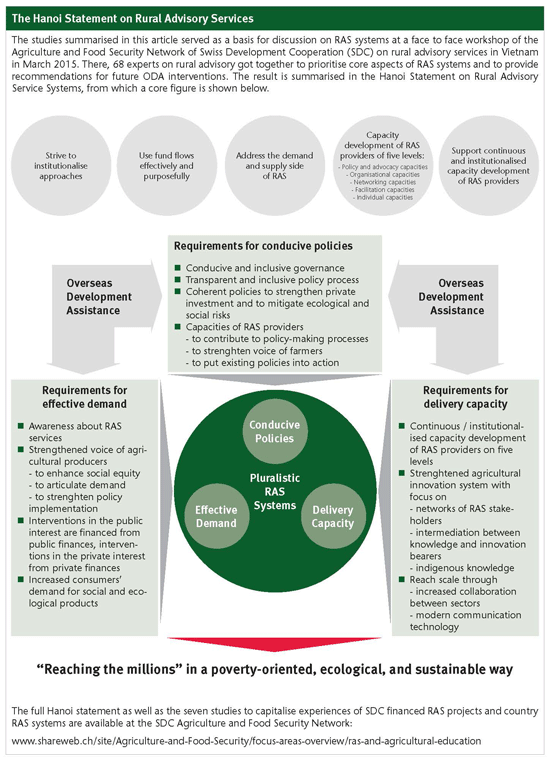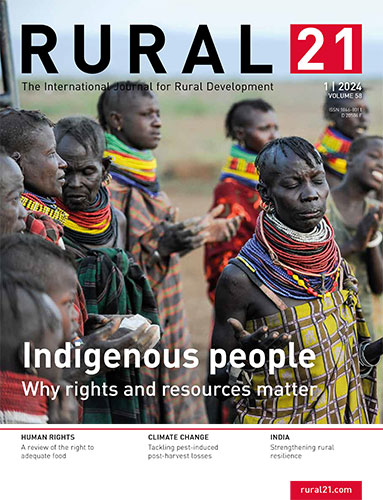 Download this article in magazine layout
Download this article in magazine layout
- Share this article
- Subscribe to our newsletter
Reaching the millions!
Current rural advisory service (RAS) systems are becoming more and more pluralistic. This is due to an increasing number of private companies involved in agricultural activities and a rising civil society providing RAS. Despite the growing number of actors, the potential for outreach of today’s RAS systems is not yet fully used. Public extension services remain the backbone of RAS systems, while private and civil RAS providers as yet only complement public services. Inter-sectorial collaboration between public, private and civil society stakeholders still rarely takes place. Thus, there is an unused potential for scale in public-private partnerships, as well as in collaboration between civil society and private agencies. This is just one of the insights gained from seven studies on advisory practice in Bangladesh, China, India, Kyrgyzstan, Laos, Nepal and Vietnam. The studies derive learning and recommendations on how RAS systems reach out to large numbers of farmers in a poverty-oriented, ecological and sustainable way.
Who pays for RAS – in theory and in reality?
In pluralistic RAS systems, a multitude of service providers interact with agricultural producers, and these service providers are funded from various sources. The underlying idea is that all services are paid by those users who have a particular interest in the services. RAS dealing with public interest is financed from public funds, while RAS catering to private interests is financed privately. Current RAS systems don’t fully reflect such market-based ideas. Instead, in today’s RAS systems,
- publicly financed RAS often serve private interests, mainly of better-off farmers;
- overseas development assistance (ODA) tends to expect private RAS stakeholders to finance services that also serve public interests, such as catering services to small-scale farmers in remote areas;
- benefits of RAS are not reliably attributed to the services, thus agricultural producers are reluctant to pay for RAS although they derive benefits from the services.
These market dysfunctions have two implications for RAS systems. On the one hand, they induce a lack of public finances where these were needed to serve public interests, e.g. for poverty reduction or sustainable resource management. On the other hand, in mainly privately financed RAS, ecological sustainability and inclusiveness are at risk. In order for ODA interventions to be sustainable, these market challenges need to be considered when supporting RAS.
How can ODA boost RAS benefits for public interests?
The studies provide three recommendations for overseas development assistance to strengthen social equity and ecological sustainability of RAS systems:
Selection of project areas according to social and agro-ecological criteria. The geographic area of ODA interventions influences inclusiveness of the supported RAS system. By supporting RAS in regions with a low agricultural potential or in areas representing a high share of disadvantaged groups, ODA increases its potential to create an inclusive intervention.
Looking for the “business case” in RAS if services are supposed to be privately financed. The so-called “business case” supports value chains to which the target group can contribute and creates a value added to the produce, allowing RAS stakeholders to finance RAS.
Only if RAS effectively support both functions of the business case can they be catered to poor smallholder producers, while being financed independently of public funds. Usually, in such market-based RAS, the definition of RAS contents is up to the market stakeholders. This renders RAS particularly prone to neglecting ecological and social priorities (e.g. focus on short-term productivity increases through high input agriculture). Hence, ODA should carefully monitor ecological effects while in parallel promoting sustainable agricultural practices and strengthening advocacy capacities of the selected target group.
Inclusion of ecological and social aspects in project planning and capacity development. ODA increases its potential to steer RAS systems’ inclusiveness by defining gender and social equity indicators right at the beginning, by monitoring them over time, and by creating affirmative action. Further, ODA can positively affect natural resource management by influencing not only the institutional setting of RAS, but also the content of RAS e.g. through well-directed capacity development of RAS providers. Similarly, capacity development of RAS providers that goes beyond technical know-how and includes e.g. advocacy capacities can positively affect inclusiveness of RAS systems.
Yet it is a major challenge for ODA to effectively support public interests in RAS. Realistic planning of ODA activities is all the more key. During planning processes, the following aspects are particularly likely to be underestimated :
- There is a trade-off between the financial sustainability of privately financed RAS, social inclusiveness and ecological sustainability of RAS. Considering this trade-off helps to plan RAS interventions realistically and to set accurate expectations. This accounts particularly for financial sustainability of RAS providers also catering to public interests.
- Up-scaling of RAS activities weakens participation of farmers and inclusiveness of RAS. Thus, monitoring and affirmative action gains in importance during up-scaling processes.
- ODA has a considerable influence on RAS contents by (co-)financing certain services and by developing capacities of RAS providers. By taking this opportunity into account, ODA makes best use of its potential to support RAS catering to sustainable resource management.
What are the roles of the diverse stakeholders?
In order for RAS systems to function effectively, there is a need for government, private and civil society initiatives to fulfil certain sector-specific roles.
The government’s key responsibility is to create an enabling environment for pluralistic and decentralised RAS. On the one hand, this comprises the support of private and civil society involvement in RAS. On the other hand, the government is accountable for an appropriate inclusion of RAS in concerned policies, as well as for decentralised planning and financing of public RAS. Besides, governments can contribute to the quality and outreach of pluralistic RAS systems by realising the following functions:
- defining RAS in public interests, and facilitating and financing its delivery;
- monitoring the quality and outreach of RAS, in particular if services are expected to cater for public interests;
- offering quality accreditation of RAS providers in order to ensure quality of services and to increase RAS providers’ potential to get mandated for service delivery.
RAS providers act as agents between farmers and institutions interested in promoting innovation, providing agricultural inputs or finances, or offering output markets. They link all relevant stakeholders in order to enhance production, innovation and marketing systems – these systems are crucial for the livelihoods of producers. The better RAS providers are connected with diverse stakeholders, the greater their potential is to offer multifunctional services. Such multifunctional RAS are most likely to be demand-driven and financially sustainable.
Project experience shows that RAS providers face challenges or lack incentives to maintain this agent function in particular when it comes to initiating and keeping up linkages.
Agricultural producers are at least partly responsible for ensuring that RAS is demand-driven and effective. However, this is only possible in an environment that enables producers to engage in RAS planning and feedback processes. Farmers further play a key role in agricultural innovation systems: they are expected to pilot new technologies, conduct on-farm research, and spread their experiences in their neighbourhood. Agricultural producers are increasingly expected to pay for RAS. However, this is only realistic if they derive private (financial) benefits from services, and if these benefits are attributed to RAS.
The role of private companies which have a demand for RAS is to facilitate and finance RAS that caters to the companies’ interests. The content and way of delivering these services considerably depends on the capacities of existing RAS providers, the legal framework of a country, and consumers’ demand for specific products, e.g. organic or fair trade-certified products.
Lessons learnt for future ODA support to RAS systems
Institutionalisation of promoted RAS approaches is key in order for ODA interventions to have a sustainable impact. In this respect, the following intervention process has turned out to be successful:
- Pilot RAS contents, methodologies, and institutional settings.
- Integrate these pilot approaches into existing structures.
- Use the pilot activities to create evidence of their benefits.
- Advocate for institutionalisation and up-scaling of promoted ideas.
By working along such an institutionalisation process, ODA projects face two basic challenges:
- In the course of project implementation, ODA’s focus often shifts from inclusiveness to institutionalisation. Since up-scaling of participatory approaches weakens participation of disadvantaged groups in RAS, ODA should address negative effects of up-scaling. In this respect, ODA can raise awareness among implementing partners, consequently monitor outcomes and create affirmative action. All require public funds to be implemented.
- Bilateral projects with the government as the main implementing partner face a dilemma when strengthening advocacy capacities of rural communities, while working exclusively through public institutions. In such a case, only a separate project component that is implemented independently from government structures can support the advocacy capacities of local communities, which are particularly important in the last step of the institutionalisation process.
In pluralistic RAS systems, RAS providers are mandated by any RAS-demanding entity to offer services. The possible mandators are the government, private or civil society stakeholders, or agricultural producers resp. their organisations. Therefore, RAS providers must be able to acquire and fulfil service mandates. Increasing RAS providers’ potential to get mandated is thus an important function of ODA.
To this end, overseas development
assistance had best support:
- a critical mass of capacitated extension workers able to offer a certain outreach of quality RAS;
- coordination of RAS providers in order to link individual extensionists to RAS-demanding entities;
- mutual information on RAS demand and supply; for this, voice of RAS providers and producer organisations is key.
Capacity development of RAS providers is another major ODA contribution. While ODA is limited in time, the adaptation of RAS to on-going environmental and socio-economic changes requires continuous capacity development. Institutionalisation of capacity development is thus essential. In this regard, three approaches have turned out to be effective:
- In a capacity building cascade, a small number of specialised extensionists train a large number of generalist extension staff. This approach is applied to initially or continuously train a large number of extensionists within a short period.
- Extension training centres act as agents between researchers, private innovation bearers, line agencies and extensionists. They provide need-based training on extension.
- Training through RAS-demanding entities: E.g. input companies, output traders, line agencies, or financial institutions train RAS providers according to their requirements. This is only possible if RAS providers are well co-ordinated and connected with demand entities.
Approach 1 and 2 require continuous investments from public funds as well as the integration of extension in academic curricula.
Decentralised financing of RAS is necessary for local ownership of RAS. ODA funds are a strategic means to support decentralised financing of RAS: ODA can, on the one hand, reinforce existing decentralised fund flows, such as government block grants, by supplementing them with project funds. On the other hand, ODA can create new decentralised fund flows e.g. by supporting commune funds that are managed locally and co-fed by the government. Not only do such locally available funds strengthen local decision-making power, they also offer hands-on practice in financial management for local government structures. Such capacities are key to the further development of decentralised finance systems.

Stefanie Kägi
stefanie.kaegi@helvetas.org
Peter Schmidt
HELVETAS Swiss Intercooperation
Zurich, Switzerland
Felix Fellmann, Rahel Meier
Swiss Agency for Development and
Cooperation (SDC)
Berne, Switzerland
References and sources for further reading
CARTER AND GIAS (2013): Making Markets Work for Poor and Extreme Poor Women in Bangladesh. The Experiences of Samriddhi. Swiss Agency for Development and Cooperation; HELVETAS Swiss Intercooperation.
ANDERSON, J. AND G. FEDER (2004). Agricultural Extension: Good Intentions and Hard Realities. TheWorld Bank Research Observer 19 (1): 41-60.
Capitalisation of experiences in SDC RAS projects (available at: www.sdc-foodsecurity.ch)
- Public Service for Agriculture and Rural Development Programme, Vietnam 2007-2015
- Sustainable Soil Management Programme, Nepal 1999-2014
- Samriddhi Local Service Provision, Bangladesh 2010-2015
- Laos Extension for Agriculture Programme, Laos 2001-2014
- Kyrgyz-Swiss Agricultural Project, Kyrgyzstan 1995-2010
Analysis of county RAS systems (available at: www.sdc-foodsecurity.ch)
- RAS systems of China and India





Add a comment
Be the First to Comment